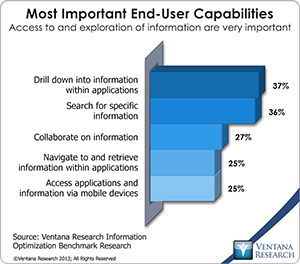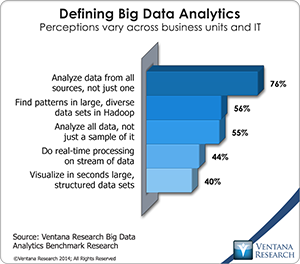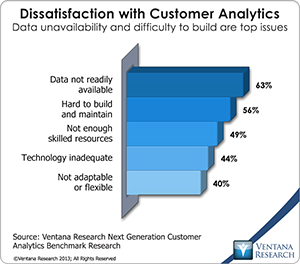Oracle is one of the world's largest business intelligence and analytics software companies. Its products range from middleware, back-end databases and ETL tools to business intelligence applications and cloud platforms, and it is well established in many corporate and government accounts. A key to Oracle's ongoing success is in transitioning its business intelligence and analytics portfolio to self-service, big data and cloud deployments. To that end, three areas in which the company has innovated are fast, scalable access for transaction data; exploratory data access for less structured data; and cloud-based business intelligence.
Providing users with access to structured data in an expedient and governed fashion continues to be a necessity for companies. Our benchmark research into information optimization finds drilling into information within applications (37%) and search (36%) to be the capabilities most needed for end users in business.
To provide them, Oracle enhanced its database in version Oracle 12c, which was released in 2013 . The key innovation is to enable both transaction processing and analytic processing workloads on the same system. Using in-memory instruction sets on the processor, the system can run calculations quickly without changing the application data. The result is that end users can explore large amounts of information in the context of all data and applications running on the 12c platform. These applications include Oracle's growing cadre of cloud based applications. The value of this is evident in our big data analytics benchmark research , which finds that the number-one source of big data is transactional data from applications, mentioned by 60 percent of participants.
Using in-memory instruction sets on the processor, the system can run calculations quickly without changing the application data. The result is that end users can explore large amounts of information in the context of all data and applications running on the 12c platform. These applications include Oracle's growing cadre of cloud based applications. The value of this is evident in our big data analytics benchmark research , which finds that the number-one source of big data is transactional data from applications, mentioned by 60 percent of participants.
Search and interactive analysis of structured data are addressed by Oracle Business Intelligence Enterprise Edition (OBIEE) through a new visualization interface that applies assets Oracle acquired from Endeca in 2011. (Currently, this approach is available in Business Intelligence Cloud Service, which I discuss below.) To run fast queries of large data sets, columnar compression can be implemented by small code changes in the Oracle SQL Developer interface. These changes use the innovation in 12c discussed above and would be implemented by users familiar with SQL. Previously, IT professionals would have to spend significant time to construct aggregate data and tune the database so users could quickly access data. Otherwise transactional databases take a long time to query since they are row-oriented and the query literally must go through every row of data to return analytic results. With columnar compression, end users can explore and interact with data in a much faster, less limited fashion. With the new approach, users no longer need to walk down each hierarchy but can drag and drop or right-click to see the hierarchy definition. Drag-and-drop and brushing features enable exploration and uniform updates across all visualizations on the screen. Under the covers,
 the database is doing some heavy lifting, often joining five to 10 tables to compute the query in near real time. The ability to do correlations on large data sets in near real time is a critical enabler of data exploration since it allows questions to be asked and answered one after another rather than asking users to predefine what those questions might be. This type of analytic discovery enables much faster time to value especially when providing root-cause analysis for decision-making.
the database is doing some heavy lifting, often joining five to 10 tables to compute the query in near real time. The ability to do correlations on large data sets in near real time is a critical enabler of data exploration since it allows questions to be asked and answered one after another rather than asking users to predefine what those questions might be. This type of analytic discovery enables much faster time to value especially when providing root-cause analysis for decision-making.
Oracle also provides Big Data SQL , a query approach that enables analysis of unstructured data analysis on systems such as Hadoop. The model uses what Oracle calls query franchising rather than query federation in which, processing is done in a native SQL dialect and the various dialects must be translated and combined into one. With franchising, Oracle SQL runs natively inside of each of the systems. This approach applies Oracle SQL to big data systems and offloads queries to the compute nodes or storage servers of the big data system. It also maintains the security and speed needed to do exploration on less structured data sources such as JSON, which the 12c database supports natively. In this way Oracle provides security and manageability within the big data environment. Looking beyond structured data is key for organizations today. Our research shows that analyzing data from all sources is how three-fourths (76%) of organizations define big data analytics.
To visualize and explore big data, Oracle offers Big Data Discovery , which browses Hadoop and NoSQL stores, and samples and profiles data automatically to create catalogs. Users can explore important attributes through visualization as well as using common search techniques. The system currently supports capabilities such as string transformations, variable grouping, geotagging and text enrichment that assist in data preparation. This is a good start to address exploration on big data sources, but to better compete in this space, Oracle should offer more usable interfaces and more capabilities for both data preparation and visualization. For example, visualizations such as decision trees and correlation matrices are important to help end users to make sense of big data and do not appear to be included in the tool.
The third analytic focus, and the catalyst of the innovations discussed above, is Oracle's move to the cloud. In September 2014, Oracle released BI Cloud Service (BICS), which helps business users access Oracle BI systems in a self-service manner with limited help from IT. Cloud computing has been a major priority for Oracle in the past few years with not just its applications but also for its entire stack of technology. With BICS, Oracle offers a stand-alone product with which a departmental workgroup can insert analytics directly into its cloud applications. When BICS is coupled with the Data-as-a-Service (DaaS) offering, which accesses internal data as well as third-party data sources in the cloud, Oracle is able to deliver cross-channel analysis and identity-as-data. Cross-channel analysis and identity management are important in cloud analytics from both business and a privacy and security perspectives.
 In particular, such tools can help tie together and thus simplify the complex task of managing multichannel marketing. Availability and simplicity in analytics tools are priorities for marketing organizations. Our research into next-generation customer analytics shows that for most organizations data not being readily available (63%) and difficulty in maintaining customer analytics systems (56%) are top challenges.
In particular, such tools can help tie together and thus simplify the complex task of managing multichannel marketing. Availability and simplicity in analytics tools are priorities for marketing organizations. Our research into next-generation customer analytics shows that for most organizations data not being readily available (63%) and difficulty in maintaining customer analytics systems (56%) are top challenges.
Oracle is not the first vendor to offer self-service discovery and flexible data preparation, but BICS begins its movement from the previous generation of BI technology to the next. BICS puts Oracle Transactional Business Intelligence (OTBI) in the cloud as a first step toward integration with vertical applications in the lines of business. It lays the groundwork for cross-functional analysis in the cloud.
We don't expect BICS to compete immediately with more user-friendly analytic tools designed for business and analytics or with well-established cloud computing BI players. Designers still must be trained in Oracle tools, and for this reason, it appears that the tool, at least in its first iteration, is targeted only at Oracle's OBIEE customers seeking a departmental solution that limits IT involvement. Oracle should continue to address usability for both end users and designers. BICS also should connect to more data sources including Oracle Essbase. It currently comes bundled with Oracle Database Schema Service which acts as the sole data source but does not directly connect with any other database. Furthermore, data movement is not streamlined in the first iteration, and replication of data is often necessary.
Overall, Oracle's moves in business intelligence and analytics make sense because they use the same semantic models in the cloud as those analytic applications that many very large companies use today and won't abandon soon. Furthermore, given Oracle's growing portfolio of cloud applications and the integration of analytics into these transactional applications through OTBI, Oracle can leverage cloud application differentiation for companies not using Oracle. If Oracle can align its self-service discovery and big data tools with its current portfolio in reasonably timely fashion, current customers will not turn away from their Oracle investments. In particular, those with an Oracle centric cloud roadmap will have no reason to switch. We note that cloud-based business intelligence and analytics applications is still a developing market. Our previous research showed that business intelligence had been a laggard in the cloud in comparison to genres such as human capital management, marketing, sales and customer service. We are examining trends in our forthcoming data and analytics in the cloud benchmark research, which will evaluate both the current state of such software and where the industry likely is heading in 2015 and beyond. For organizations shifting to cloud platforms, Oracle has a very progressive cloud computing portfolio that my colleague has assessed and they have created a path by investing in its Platform-as-a-Service (PaaS) and DaaS offerings. Its goal is to provide uniform capabilities across mobility, collaboration, big data and analytics so that all Oracle applications are consistent for users and can be extended easily by developers. However, Oracle competes against many cloud computing heavyweights like Amazon Web Services, IBM and Microsoft, so achieving success through significant growth has some challenges. Oracle customers generally and OBIEE customers especially should investigate the new innovations in the context of their own roadmaps for big data analytics, cloud computing and self-service access to analytics.
Regards,
Tony Cosentino
Vice President and Research Director

 Using in-memory instruction sets on the processor, the system can run calculations quickly without changing the application data. The result is that end users can explore large amounts of information in the context of all data and applications running on the 12c platform. These applications include Oracle's growing cadre of cloud based applications. The value of this is evident in
Using in-memory instruction sets on the processor, the system can run calculations quickly without changing the application data. The result is that end users can explore large amounts of information in the context of all data and applications running on the 12c platform. These applications include Oracle's growing cadre of cloud based applications. The value of this is evident in the database is doing some heavy lifting, often joining five to 10 tables to compute the query in near real time. The ability to do correlations on large data sets in near real time is a critical enabler of data exploration since it allows questions to be asked and answered one after another rather than asking users to predefine what those questions might be. This type of analytic discovery enables much faster time to value especially when providing root-cause analysis for decision-making.
the database is doing some heavy lifting, often joining five to 10 tables to compute the query in near real time. The ability to do correlations on large data sets in near real time is a critical enabler of data exploration since it allows questions to be asked and answered one after another rather than asking users to predefine what those questions might be. This type of analytic discovery enables much faster time to value especially when providing root-cause analysis for decision-making. In particular, such tools can help tie together and thus simplify the complex task of managing multichannel marketing. Availability and simplicity in analytics tools are priorities for marketing organizations.
In particular, such tools can help tie together and thus simplify the complex task of managing multichannel marketing. Availability and simplicity in analytics tools are priorities for marketing organizations. 







